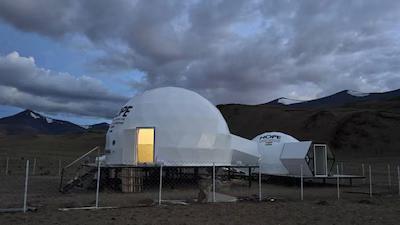
ISRO Sets Up Station in Ladakh to Simulate Life on Moon & Mars
The Indian Space Research Organisation (ISRO) has taken a significant step towards exploring the vast expanse of space by setting up the Himalayan Outpost for Planetary Exploration (HOPE) in Ladakh’s Tso Kar Valley. This unique facility is designed to simulate the harsh conditions of the Moon and Mars, allowing scientists to test life-support systems for future lunar and Martian missions.
The Tso Kar Valley, located at an altitude of 4,500 meters, was chosen for its extreme environment, which mirrors the conditions on Mars. The valley receives high UV radiation, has low atmospheric pressure, and is characterized by extreme cold and saline permafrost – all of which are similar to the Martian terrain.
From August 1 to 10, two crew members will undertake various tests at the HOPE facility, pushing the limits of human endurance in a bid to understand how astronauts will fare in the unforgiving environment of space. The 10-day simulation mission aims to validate the designs of life-support systems, habitats, and equipment that will be used in future missions to the Moon and Mars.
The HOPE facility is a mini-Mars setup, designed to replicate the Martian environment. The crew members will live and work in the facility, conducting experiments, and performing routine tasks, just as they would on a real Mars mission. The facility is equipped with cutting-edge infrastructure, including airlocks, life-support systems, and communication equipment, which will be tested during the simulation.
The mission is a significant milestone in ISRO’s plan to send humans to space in the coming years. The organization has already made significant progress in its human spaceflight program, with the successful launch of the Gaganyaan crew module in January 2022. The next step is to develop the necessary infrastructure and technologies to support human missions to the Moon and Mars.
The HOPE facility is designed to withstand the extreme temperatures, high UV radiation, and low atmospheric pressure that are characteristic of the Martian environment. The crew members will be equipped with specialized suits and equipment to protect them from the harsh conditions, but they will still be subjected to the challenges of living in a Martian-like environment.
The simulation mission will test various aspects of life in space, including:
- Life-support systems: The facility will test the ability to sustain life for extended periods in a hostile environment. This includes the air, water, and food systems, as well as waste management and recycling.
- Habitats: The HOPE facility will test the design and functionality of habitats that can be used on future missions to the Moon and Mars. The habitats will be designed to provide a safe and comfortable living environment for astronauts.
- Equipment: Various pieces of equipment, including communication systems, navigation tools, and medical supplies, will be tested during the simulation to ensure they are suitable for use in space.
- Psychological factors: Living in space for extended periods can be mentally challenging, and the simulation mission will test the psychological well-being of the crew members.
The success of the HOPE facility will pave the way for future human missions to the Moon and Mars. The experience gained from this simulation mission will be invaluable in developing the necessary technologies and infrastructure to support human exploration of space.
In conclusion, the ISRO’s Himalayan Outpost for Planetary Exploration (HOPE) in Ladakh’s Tso Kar Valley is a significant step towards realizing India’s vision of exploring the vast expanse of space. The simulation mission will provide valuable insights into the challenges of living in space and will help develop the necessary technologies and infrastructure to support human missions to the Moon and Mars.
Source:






